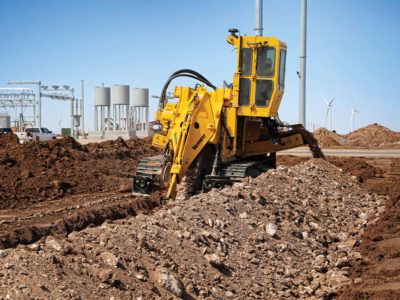Vermeer trenchers come in a wide range of sizes, from 13-hp (10-kW) pedestrian trenchers up to massive 600-hp (447-kW) trenchers that can cut a ditch 15-ft (4.6-m) deep and 48-in (121.9-cm) wide.
With so many sizes and configurations, how do you choose the right trencher for your next job?
Trencher categories
To begin your search, start with what size trencher you need. The industry will typically group trenchers into three categories.
- Pedestrian or walk-behind trenchers are used for shallow work, including electrical, irrigation and fiber installs.
- Utility ride-on trenchers are used for deeper utility installation. They usually work over longer distances in softer soil conditions like clay and loam. This category of trencher is often used for installing fiber, underground distribution electrical lines, and connecting solar farms and wind turbines to the electrical grind.
- Large trenchers are used for cutting deep and wide trenches in hard clay and rocky ground conditions. These impressive machines can help optimize your crews’ production by installing large diameter casing and HDPE pipe at deeper depths. This is often required for performing electrical connections on renewable energy projects, as well as pipeline work for oil and gas, water and sewer, and the hardening (undergrounding) of electrical transmission lines.
Narrowing your search
Within each trencher category, there are various models that could be a fit for your work. Consider these factors to choose which trencher models will deliver the optimal performance for your project:
- Required trench depth and width
- Ground conditions
- Diameter of the product being installed
You will likely choose a utility or pedestrian trencher for shallower depths in ideal soil conditions. For these categories of trenchers, a suitable model for your needs will largely depend on trench depth and width requirements.
In challenging ground conditions, like rock, you’ll need a larger trencher that can produce more torque to cut a ditch efficiently. Higher torque is also required for cutting deeper and wider ditches.
However, high torque levels come at a cost. Larger trenchers burn more fuel. So, you shouldn’t simply choose the largest trencher model for every project. Instead, select a trencher model that will help you balance productivity with operating efficiency.
No matter which category of trencher you need, Vermeer offers one of the industry’s broadest trencher lines in all three trencher categories with multiple models, configurations and attachments. For now, though, let’s take a look at the large trencher category.
Choose a large trencher for your specific application
Vermeer offers eight large trencher models for you to choose from. They all share similar features to help you maximize your production, but certain models can better support specific installation projects than others.
Large trenchers are an efficient equipment solution in a wide range of industries. In fact, in challenging ground conditions, a single trencher can be more efficient than excavators. That helps you optimize your labor force and your fleet, as you’ll only need one operator on one machine instead of multiple operators on multiple machines.
Here are a few applications you use a trencher for.
- Pipelines — For natural gas and oil pipeline installations, the trench has to be cut deep enough to accommodate the pipeline, plus several feet of fill between it and the surface. For this industry, you will likely need to dig deep and wide. In many environments, you may be able to get by with a smaller Vermeer trencher model. But, if you’re working in harder rock, your project will benefit from a higher horsepower trencher.
- Electrical transmission lines — There will be tremendous growth for this work over the next several years within solar and wind farm construction projects and the hardening (undergrounding) of electrical transmission lines. Electrical lines with HDPE casings are often buried at depths between 6 ft to 8 ft (1.8 m to 2.4 m). Trench width can vary based on the size of the bundle of lines being installed.
- Water and sewer installations — For new urban subdivision development, trenchers are an efficient option for water and sewer installs.
- Water management — Trenchers can also be deployed on water management projects, including tiling farmland and digging drainage ditches.
Matching your needs
Vermeer offers a wide range of trencher models to choose from. If you want more insight from a local pro, contact your Vermeer dealer. Whether you need a pedestrian trencher or the largest trencher available, they will help you get the right unit to help maximize your crew’s productivity.
Vermeer Corporation reserves the right to make changes in engineering, design and specifications; add improvements; or discontinue manufacturing at any time without notice or obligation. Equipment shown is for illustrative purposes only and may display optional accessories or components specific to their global region. Please contact your local Vermeer dealer for more information on machine specifications.
Vermeer, and the Vermeer logo are trademarks of Vermeer Manufacturing Company in the U.S. and/or other countries. © 2022 Vermeer Corporation. All Rights Reserved.
